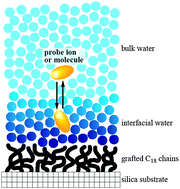Interfacial water on hydrophobic surfaces recognized by ions and molecules†
Abstract
Recent spectrophotometric and molecular dynamics simulation studies have shown that the physicochemical properties and structures of

* Corresponding authors
a
Graduate School of Science and Technology, Saitama University, 255 Shimo-Okubo, Sakura-ku, Saitama, Japan
E-mail:
sibukawa@apc.saitama-u.ac.jp
Fax: +81 48-858-3520
Tel: +81 48-858-3520
Recent spectrophotometric and molecular dynamics simulation studies have shown that the physicochemical properties and structures of

 Please wait while we load your content...
Something went wrong. Try again?
Please wait while we load your content...
Something went wrong. Try again?
M. Shibukawa, Y. Kondo, Y. Ogiyama, K. Osuga and S. Saito, Phys. Chem. Chem. Phys., 2011, 13, 15925 DOI: 10.1039/C1CP20704K
To request permission to reproduce material from this article, please go to the Copyright Clearance Center request page.
If you are an author contributing to an RSC publication, you do not need to request permission provided correct acknowledgement is given.
If you are the author of this article, you do not need to request permission to reproduce figures and diagrams provided correct acknowledgement is given. If you want to reproduce the whole article in a third-party publication (excluding your thesis/dissertation for which permission is not required) please go to the Copyright Clearance Center request page.
Read more about how to correctly acknowledge RSC content.
 Fetching data from CrossRef.
Fetching data from CrossRef.
This may take some time to load.
Loading related content
